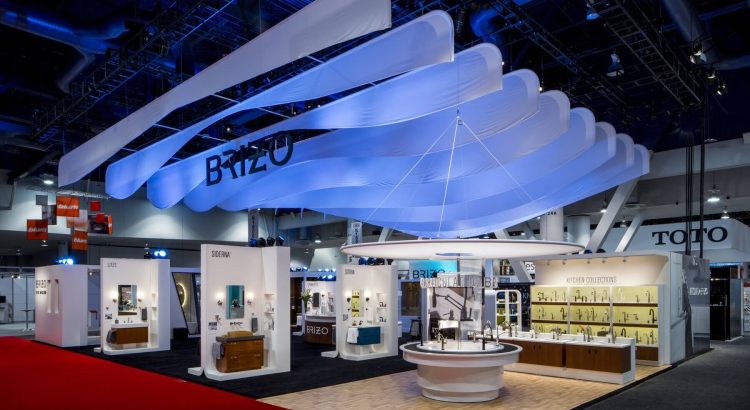Trade shows are high-stakes environments where first impressions matter. In a sea of competitors, your booth has only seconds to grab attention. Whether you’re a seasoned exhibitor or planning your first trade show presence, booth design is one of the most powerful tools you have to stand out. A well-designed exhibit doesn’t just attract attendees—it invites engagement, supports your brand story, and ultimately drives business results.
Here’s how to design a trade show booth that doesn’t just show up—but stands out.
1. Start With a Clear Objective
Before diving into design decisions, define your primary goal. Are you launching a new product? Generating leads? Building brand awareness? Your objectives will inform everything from booth layout and graphics to technology choices and staffing needs.
For example, a brand focused on lead generation may benefit from open layouts that invite attendees in and feature multiple demo stations or meeting areas. In contrast, a company debuting a new product might design the space around a central stage or display area to draw eyes and spark conversations.
2. Make an Immediate Visual Impact
First impressions are made in three to five seconds. Your booth should clearly communicate who you are and why someone should stop.
- Bold branding: Your logo, tagline, and brand colors should be highly visible and consistent throughout the booth. Avoid clutter. Simple, high-contrast visuals are more effective than dense text or overcomplicated graphics.
- Height and lighting: Use vertical elements to catch the eye from across the show floor. Towering signs, hanging structures, or illuminated headers give your booth prominence. Strategic lighting—whether overhead, accent, or backlighting—can highlight focal points and add depth to the space.
- Dynamic visuals: Incorporate motion with LED walls, video displays, or kinetic signage. Movement naturally draws attention and can be used to tell your story quickly and memorably.
3. Prioritize Layout and Flow
Great booth design isn’t just about aesthetics—it’s about how people move through and interact with your space.
- Open layouts: Avoid barriers like high tables or cluttered displays that discourage people from entering. Use inviting entrances and clear paths to draw attendees in and guide them through your experience.
- Zones with purpose: Organize your booth into functional areas—product displays, demo stations, meeting space, and casual conversation areas. This not only improves flow but allows you to engage different types of visitors based on interest level and stage in the buying cycle.
- Storage considerations: Incorporate hidden storage to keep the booth clean and uncluttered. A tidy space is more inviting and reinforces professionalism.
4. Create Interactive Touchpoints
Engagement is everything at a trade show. The more interactive your booth, the more time attendees will spend there—and the more likely they are to remember your brand.
- Product demos: Let visitors see, touch, and try your offerings. A hands-on experience is far more memorable than a static display or pitch.
- Technology integration: Touchscreens, AR/VR, or digital product catalogs can add interactivity and collect visitor data. Just be sure tech is intuitive and adds value—it shouldn’t be there just for show.
- Gamification: Games, contests, or challenges with small rewards can create buzz and drive booth traffic. Make sure any activation ties back to your brand message or offering.
5. Design for Comfort and Conversation
Trade shows can be exhausting. Providing a place to relax can turn a passerby into a captive audience.
- Comfortable seating: Offering lounge areas or soft seating encourages longer conversations and gives your team a natural way to start a dialogue.
- Private meeting spaces: If your goal is closing deals or having in-depth discussions, include semi-private areas where noise and distractions are minimized.
- Hospitality elements: Small touches like charging stations, beverages, or giveaways can enhance comfort and show thoughtfulness, making your booth more welcoming.
6. Don’t Forget the People Factor
Even the best-designed booth will fall flat without the right team. Your staff should be trained, professional, and aligned with your booth’s objectives.
- Dress appropriately for your brand.
- Be proactive but not pushy.
- Know your talking points and how to guide visitors through the space.
The human element is often the most memorable part of a trade show experience—make sure yours leaves a lasting impression.
7. Test, Learn, and Evolve
Finally, treat each trade show as a learning opportunity. Track visitor flow, engagement levels, and outcomes. Gather feedback from attendees and your team. Use that insight to refine your design for future events.
A successful booth is never static. Trends change, products evolve, and audience expectations shift. Stay flexible, stay creative, and continue to innovate.
Conclusion
In the high-energy, high-stakes world of trade shows, your booth design can be the difference between being noticed—or being ignored. With clear goals, impactful visuals, smart layout, and a focus on engagement, your booth can rise above the noise and make a statement that lasts long after the event ends.
Whether you’re working with a 10×10 space or a custom island exhibit, the principles remain the same: design with purpose, lead with brand, and always put the visitor experience first. We recommend trade show exhibits.





